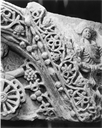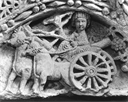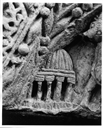| Showing 1 of 1 |
|
Return of Dionysos
Early Byzantine
late 5th century - 6th century
45 cm x 117.5 cm x 34.5 cm (17 11/16 in. x 46 1/4 in. x 13 9/16 in.)
limestone
BZ.1943.6
On view
Permalink:
http://museum.doaks.org/objects-1/info/36594
Keywords
This object has the following keywords:
Arched,
Beaded,
Biconical-Bead,
Bulls,
Busts,
Circular,
Dionysus,
Domed,
Floral,
Fully Draped,
Grapes|Bunch of Grapes,
Lotus Pods,
Niches,
Spandrels,
Temples,
Vegetal|Vegetal Scrolls,
Vine Trellis,
Wagons,
Whips,
Wreaths
- Arched
- Beaded
- Biconical-Bead
- Bulls
- Busts
- Circular
- Dionysus
- Domed
- Floral
- Fully Draped
- Grapes|Bunch of Grapes
- Lotus Pods
- Niches
- Spandrels
- Temples
- Vegetal|Vegetal Scrolls
- Vine Trellis
- Wagons
- Whips
- Wreaths
Additional Images
Object Last Modified: 3/8/2023




